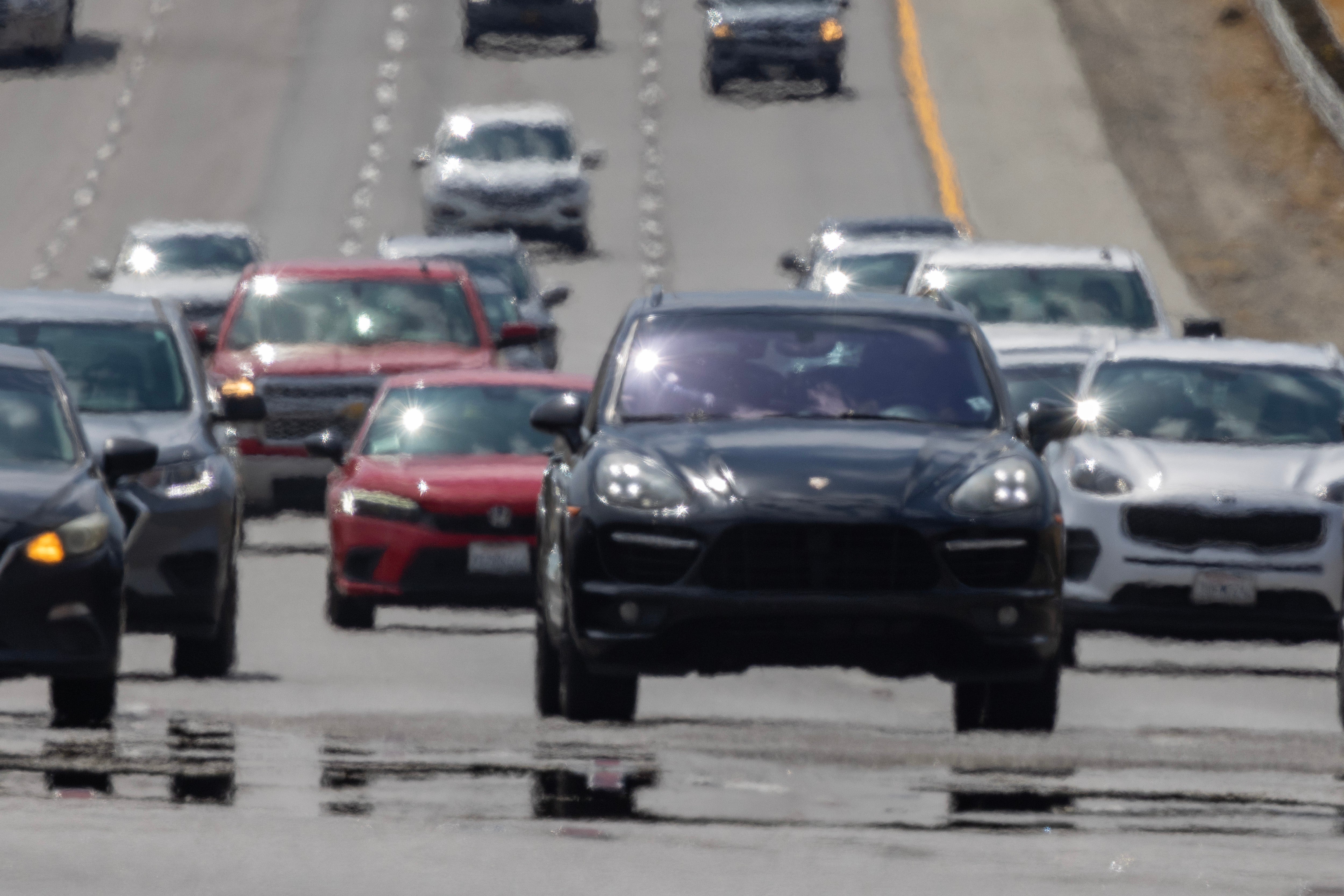

CLIMATEWIRE | As the hottest summer of what is expected to be the hottest year on record winds down, millions of American families will hit the road for a brief respite before what forecasters say will be a warmer-than-average autumn.
Even the hardiest of travelers will face a climate stress test.
Extreme heat is expected to persist in the Sunbelt, with temperatures that could reach the high 90s and even top 100 degrees Fahrenheit from Nevada and Arizona to Texas and the Gulf South, according to NOAA’s three-month forecast for September, October and November.
Those not dripping sweat in the Sunbelt may dodge rain bombs, pole-snapping winds and floodwaters as more extreme storms track across the eastern half of the country. Wildfire smoke will move outdoor parties indoors. Scorching beach sand and bathtub-warm ocean water won’t offer much relief.
For those brave enough to venture from home air-conditioning, here are four ways this summer’s hellish climate may affect your end-of-summer travels.
Buckled in, buckled up, buckled roads
Highway engineers call it “buckling” when overheated segments of concrete in highways expand and collide. Sometimes buckling creates a bulge that looks like a speed hump. Other times, it destroys enough concrete to create a road rupture that can break an axle.
Asphalt has an opposite problem. Triple-digit temperatures can render it soft, experts say, while continuous traffic on an asphalt-paved road can create a “wagon trail” effect that presses tire-track depressions into a highway. Constant pressure causes cracking, which in turn leads to potholes and erosion.
Most state highway departments don’t keep reliable statistics on buckling and potholes, but experts say they are most common in regions that experience dramatic swings between winter and summer temperatures, known as a freeze-thaw cycle. But extreme heat alone can cause a road to buckle simply by expanding concrete beyond its pressure tolerance.
A 2013 study from the University of Colorado, Boulder, found that federal, state and local governments spent an estimated $134 billion on U.S. road surface repairs annually, a figure that has risen with the costs of labor, materials and other inflationary pressures. Without measures to rein in climate warming, those costs would increase from between $785 million and $2.8 billion by 2050, the researchers found.
Today, “many areas are seeing a doubling of those costs,” said Paul Chinowsky, an emeritus professor of civil, environmental and architectural engineering at the University of Colorado, Boulder, and primary author on the study. And while advances in materials science are helping engineers build stronger roads, the combination of heat and pressure on concrete can test even the strongest roads.
“It’s nearly impossible to put a broken road back together,” Chinowsky said. “It’s like puzzle pieces coming apart.”
Where there’s smoke, there’s trouble
Smokey Bear needs a new slogan: “Only YOU can prevent roadside fires made worse by climate change.”
Fires and smoke plumes along U.S. roads are getting larger, denser and harder to manage under increasingly hot and dry conditions.
In June, law enforcement officials closed a 25-mile stretch of the Garden State Parkway in New Jersey as smoke from a 5,000-acre wildfire blanketed the highway north of Atlantic City.
A week later in northern Minnesota, law enforcement closed a stretch of U.S. 53 near Duluth after plumes from a series of roadside fires impaired visibility. The cause? An overheated tractor-trailer tire that caught fire.
These are examples of roadside or near-highway fires that impede traffic and put drivers at risk along U.S. highways.
The American Association of State Highway and Transportation Officials says roadside fires are increasing in many parts of the U.S. and are “partially amplified by climate change and increased traffic volumes as well as stress on maintenance budgets.”
Most are small and go unreported. But roadside and median fires are no longer minor events.
Researchers at Texas A&M Forest Service say such fires can be avoided by simple measures, including avoiding parking warm vehicles on dry vegetation where engine heat can ignite what’s underneath. And when pulling a trailer, secure tow chains to prevent sparks caused by contact with road surfaces from igniting roadside debris and vegetation.
High heat, low tires, big boom
It’s a basic law of thermodynamics. Hot air expands. And when a hot car tire gets hotter from friction against a road surface, the consequence can be, well, explosive.
According to the National Transportation Safety Board, tire failures on cars and trucks cause more than 30,000 crashes annually in the U.S. and injure roughly 19,000 people. Summer driving accounts for the largest share of crashes.
While it seems counterintuitive, underinflated tires in extreme heat can be more dangerous than overinflated tires because softer tires make more surface contact with hot pavement, experts say. Studies show that on a 95-degree day, pavement temperatures can reach 170 degrees.
That’s why vehicle tires are temperature-rated for performance, with A-rated tires meeting the highest heat thresholds. Experts also warn against driving winter tires on hot roads because the rubber compounds used in winter tires are softer and more susceptible to heat-induced blowouts.
Andreas Schlenke, a tire development expert for manufacturer Continental AG, the third-largest new-tire seller in the U.S. and Canada, warned in a recent blog post that an underinflated tire can result in “tire shoulder and sidewall deformation,” making it even more vulnerable to heat stress. “If all these factors combine or if the tire has been previously damaged by curb contact or the like, a blowout is a distinct possibility,” he said.
Heavy and overloaded vehicles in extreme heat are particularly susceptible to sidewall blowouts, according to Chicago-based United Tires, a nationwide used-tire seller. Information about proper tire inflation and maximum load are easily found on a driver’s side door frame.
Experts also note that tire pressure should be measured at the beginning of a long trip, when tires are cool, not at the fuel or charging station after 100 miles.
Pain in the gas
If you haven’t looked at pump prices lately, get ready for sticker shock.
The average price of a gallon of unleaded in Los Angeles and San Francisco last week had soared past $5, according to the website GasBuddy.com. The price in Chicago was hovering around $4.50 per gallon, while Washington, D.C., is pushing $4.
That can be a budget-buster for a family road trip to grandma’s house. While many factors affect pump prices, including production curtailment and price manipulation among oil-producing nations, climate disasters can take their own toll.
Hurricanes and extreme storms can cut power and other essential utilities to marine and truck terminals, refineries, pipelines and other infrastructure necessary to move fuels from producers to consumers.
And extreme heat, like that gripping much of the oil and gas belt this summer, can force refineries to reduce capacity for safety and operational reasons while also zapping fuel economy, meaning it requires more fuel to go less distance.
And as in any complex distribution system, decisions must be made about managing existing resources and prioritizing supply to high-demand areas or for specific purposes.
Climate policy decisions also can affect fuel prices, as was the case in Washington state when gas prices began rising after the January rollout of a new carbon “cap-and-invest” program meant to boost climate initiatives. Critics said compliance with the program, including among farmers, fishermen and Native American tribes, was putting upward price pressure on fuel.
By June, Washington state’s average pump price had climbed 41 cents per gallon higher than neighboring Oregon’s, according to AAA. The gap had closed to 33 cents as of last week.
Reprinted from E&E News with permission from POLITICO, LLC. Copyright 2023. E&E News provides essential news for energy and environment professionals.
Source link





